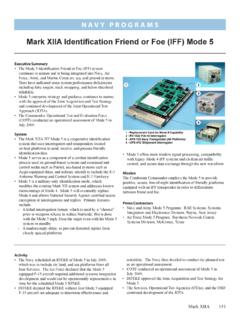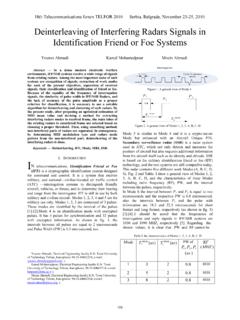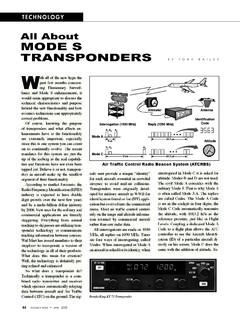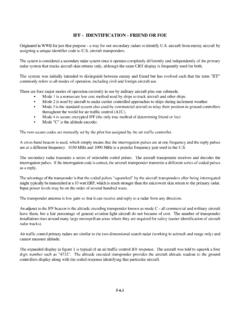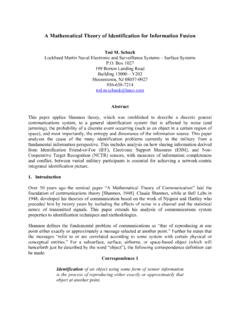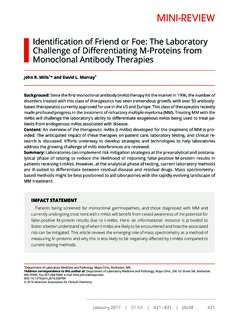Transcription of Friend or Foe? - U.S. Naval Research Laboratory (NRL)
1 Friend or Foe?It is 1100 BCE on the eastern banks of the Jordan River. Several checkpoints along the river ensure the safety of the border between Gilead on the eastern shore and Ephraim on the western shore. Ephraimites recently invaded, but their attempted occupation is failing. Gileadite border patrols and military checkpoint personnel have been warned about enemy deserters attempting to re-cross the Jordan. However, identifying Friend or foe is a problem, since both groups are ethnically, linguistically, and culturally related. A commander, familiar with the various dialects in the region, orders all security personnel to interrogate individuals traveling west, by asking them to say the word meaning stream or ford. He informs his forces that their enemies, the Ephraimites, will not pronounce this word shibboleth with an initial sh-sound, as in the word shoe.
2 Instead, they will say sibboleth, since their dialect does not permit words to begin with the sound sh. According to the book of Judges 12:5-6, the Gileadites defeated the Ephraimites and blocked their safe return to their homeland on the other side of the Jordan. Three thousand years later, using a person s speech for linguistic and cultural identity continues to be of interest to the military and intelligence communities. The Naval Research Laboratory s Shibboleth project uses the phonological information contained in a speaker s accent to make determinations about that individual s native language and Research | 2012 NRL REVIEWLANGUAGE AS AN INDICATOR From Biblical times to World War II, military and intelligence-gathering individuals have been using dialect variation and accents to isolate what are called phonological shibboleths to identify individuals backgrounds, nationalities, and cultures, and in so doing distinguish Friend from foe.
3 For example, forces stationed in northern Europe used one shibbo-leth to distinguish friendly Dutch-speaking forces and citizens from the potential German-speaking enemy. To the untrained American listener, Dutch and German speakers sound similar, as do their accents when these individuals are speaking English. If a soldier was doubtful about an individual s identity or background, he knew that he could easily distinguish between the two nationalities by asking the individual to pronounce the name of the Dutch seacoast town, Schevenigen. A German, untrained in the Dutch language, would have some difficulty replicating the complex word-initial consonant cluster of Sxevenigen, instead pronounc-ing it as Shevenigen. Today, in our post-9/11 world, quick identification of friends and foes, terrorists and non-terrorists, has become a crucial aspect of national defense and a main component of the global war on terrorism.
4 To aid in the identification of potential threats, various biometric devices are used in conjunction with metal and explosive detectors. Retinal scans and fingerprinting, for example, are used, but these meth-ods take time and resources that may not be readily How Do You Say It?Shibboleth: Phonological Analysis of Non-Native Speakers of Frost, Perzanowski, and PageInformation Technology DivisionTo assist in the war on global terrorism, the Naval Research Laboratory s Shibboleth project is investigating the speech of non-native speakers of English. At military checkpoints around the world, warfighters typically speak in English when they interrogate individuals wishing to cross the checkpoints. The respondents, non-native English speakers, reply in English. By studying the speech of these non-native speakers, linguists at NRL are determining the phonological rules that characterize or distinguish accents of non-native English speakers.
5 With this information, we can determine the native language of the speakers using rule-based phonological patterns. This helps to identify potential threats when, for example, an individual is trying to hide something or avoid identification by lying about himself or herself. Knowing the phonological identity or correctly identifying the accent of an individual can aid the warfighter in determining whether persons of interest are telling the truth or lying about their identities. available at a busy or remote border station or check-point. To supplement and enhance these techniques, the Naval Research Laboratory s Shibboleth project seeks to enable phonological analysis of individuals speech to determine a person s linguistic background, by comparing and contrasting known phonological variations in speech and accents with those of suspect persons. While individuals might hide behind the guise of another nationality, using a forged passport, for example, people have a difficult time hiding their lin-guistic identity.
6 People may attempt to train themselves to speak differently, by mimicking a different dialect or accent, but phonological analyses of their speech pat-terns can detect the disguise or inconsistency. This type of analysis can be used today in countries like Afghani-stan, where six different native languages are dominant in its 34 provinces (Fig. 1). Even for a linguistically trained warfighter who may be familiar with one or two of those languages, this is a daunting situation. THE PHONOLOGICAL BASES Of LANGUAGE Speech is the result of various muscle movements in the oral cavity that incorporates the nasal passage, mouth, and lips, and extends to the larynx or pharynx (Fig. 2). These movements, coupled with air expelled from the lungs and modulated by the vocal cords, create differences in sound and produce changes in air pressure. These differences can be seen in a spectro-gram (Fig.)
7 3) that records the amount of air pressure produced over time. The more vividly colored bands Friend or Foe?842012 NRL REVIEW | featured Research (pink and blue) in the spectrogram, for example, ex-hibit a concentration of air pressure measured in hertz (Hz). Typical human speech ranges from 300 to 3500 Hz. Because varying air pressure and altering the con-figuration of the various speech apparatuses mentioned above causes all human speech sounds, spectrograms offer an excellent depiction of what speech sounds look like when visually mapped to a representation of what is happening inside the human anatomy. A gloss in Fig. 3 indicates where the various sounds or phones of the utterance Show me your occur, and the spectro-gram offers a visual representation of the amount of acoustic energy or air pressure measured at the various points along the speech continuum.
8 This provides information about various acoustic features that characterize speech sounds. For example, the difference between the initial sound or phone in pat and bat is what is known as voicing. In pat, the initial sound is called voiceless because no air is being forced out of the lungs and modulated by the vocal cords. On the other hand, in bat, the initial sound is voiced because air is being expelled from the lungs causing the vocal cords to vibrate. Other distinc-tive phonetic features can be used to identify speech sounds. Typically, these features are constrained to a binary representation so that the feature [+/ voice] is realized as [+voice] for the phone b and [ voice] for the phone p. Coupled with the acoustic depiction of speech sounds is the classification of speech sounds by manner of articulation. This set of classifiers captures how the musculature is manipulated and how various articula-tors, such as the tongue and teeth, are used to produce a particular sound.
9 For example, we say that both b and p are bilabial, since they employ the use of the lips in producing the sounds. Thus, these two phones employ the feature of [+/ bilabial]. Both b and p are [+bila-bial] and with the acoustic feature discussed above, b = [+voice, +bilabial] and p = [ voice, +bilabial]. Using such features, we distinguish these two phones, but we also distinguish them from other phones, such as d = [+voice, bilabial] and t = [ voice, bilabial]. Using this system of binary classification, we can distinguish the various speech sounds of the world s languages. The International Phonetic Association (IPA), founded in Paris in 1886, continues to have as its aim the creation and maintenance of a standard of phonetic representa-tion for all of the sounds of the world s languages. (See Fig. 4 for a representation of an IPA chart depicting the sounds of American English.)
10 However, human speech does not consist of individual phones uttered, but of sequences of sounds in various combinations. Phonology is the science that constructs rules that characterize how the vari-ous phones of the world s languages are combined. Languages exhibit rules that either permit or restrict FIGURE 1 Majority languages spoken in the provinces of 2 Cutaway diagram of the human vocal 3 Spectrogram of the phrase Show me your 85featured Research | 2012 NRL REVIEWthe combination of certain sounds in that language. We have seen examples of some restrictions in histori-cal examples above. The phonologist determines what those permissions and constraints are and characterizes them for various human languages. By doing so, the phonologist is both depicting what is permissible in a particular language and predicting what is impermis-sible.

